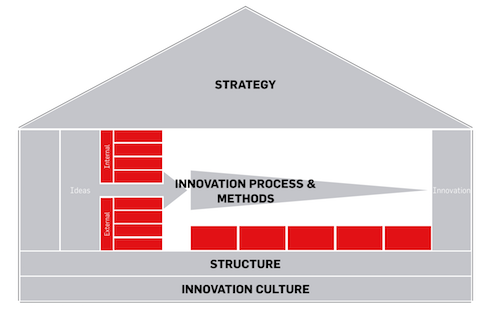Creating space for innovation: 5 learnings on how New Work can succeed in your company
The trend toward New Work has existed for several years. So has the desire of many employees to work more flexibly on a permanent basis. As a catalyst, the Corona crisis has accelerated this development enormously. This article explains why New Work as the new standard is not a short-term trend and how companies can master this challenge and use it for innovation.

1. The changes are permanent
The forced digitalization push has abruptly catapulted many companies into the new world of work. Companies that were already familiar with digital working methods were able to adapt very quickly to the new circumstances. The vast majority, on the other hand, were busy setting up a new infrastructure in the first few weeks. Production companies were hit particularly hard.
However, the survey of 300 companies as part of Deloitte Austria's Flexible Working Study 2020 shows just how shallow the learning curve can be in states of emergency:
- Rapid increase:96% of companies used home office extensively in lockdown.
- Rapid digitization: 82% of business owners created the technical conditions for near-ubiquitous home office within a few days.
- Digital tools:84% use more digital communication tools than before Covid-19.
- Remote work:More than 80% expect more home offices in the company on a permanent basis.
- New perspective: 86% of companies have a new basic understanding of the need for physical meetings.
- Availability:70% say virtual availability has become very important in the company.
So flexible working remains as a fixed component in many companies, even after Corona. New hybrid forms of virtual and physical collaboration will emerge, necessitating a rethink of current ways of working.
2. Employee acceptance is critical to success
New Work is characterized by new forms of work that require greater flexibility at the organizational level, but also at the personal level of the employee, since the boundaries between private and professional life will become even more blurred in the future. The acceptance of this development and the self-responsibility of the employees is critical to the success of New Work approaches in a company. Binding structures and clear rules are important in this context:
- What availability is expected of employees in the home office?
- How are unavailabilities communicated to colleagues?
- For which activities is mobile working suitable and for which not?
- When and why is office presence still required?
How can employees counteract an unhealthy separation of work and private life in the home office and how can the company support them in this?
3. New forms of work require planning and training
Flexible working gives employees more responsibility and more self-determination as to how and when they do their work. Not only does this not suit every employee but it does not suit every company structure either. New forms of work must therefore be well thought out and adapted to the company.
Basically, changes are needed in three areas to create the structural conditions for New Work in companies:
- Restructuring of the working environment:This concerns both the spatial and temporal framework conditions. Classic examples are open office concepts, the 4-day week or the 6-hour day.
- Technical structures:In order for employees to be able to work regardless of location, the appropriate IT infrastructure must be in place. The distribution of costs between employees and the company should be clearly regulated. In many companies, this point is still a gray area.
- Company and process structures: Agile organizational models and agile teams are examples of changed corporate structures necessitated by New Work.
Personal responsibility, flexibility, and agility place high demands on self-management and know-how in dealing with digital tools. While digital natives are able to adapt quickly to flexible forms of work, this very quickly leads to excessive demands on older or less IT-savvy employees.
In addition to organizational/process-related changes, attention should also be paid to training employees and managers (leadership at a distance) so that they can meet the demands of new forms of work. Providing the hardware alone is usually not enough.
4. New Work is first and foremost a cultural change
Creating structures that enable new forms of work does not make New Work successful. Companies often overlook the fact that new working environments primarily require a change in corporate culture.
In particular, the transformation from strongly hierarchy-oriented organizational structures to network organizations is an enormous step - both from a cultural and a leadership perspective.
Managers actually play a central role in the introduction of new working worlds and agility, because in addition to the "ability" of all employees, the "will" and commitment of management is essential for a successful transformation.
5. New Work has positive effects on innovation
„May“, „Can“ and „Want“ are also the prerequisites for a positive innovation culture:
- Permission to try out new things, including proper error culture,
- time and financial resources for innovation projects as well as training in innovation methods, and
- motivation through self-determination and self-realization.
 © LEAD Innovation "House of Innovation"
© LEAD Innovation "House of Innovation"
„A positive innovation culture as the foundation for holistic innovation management.“
It is therefore interesting for us to see how a New Work corporate culture almost automatically creates space for employee-driven innovation.
We are now getting a lot of requests to accompany companies in designing processes for this new exciting playing field, as digitalization has drastically changed the way ideas are created and communicated internally. New communication channels need to be created and the "rules of the game" made easily accessible to all internal idea generators and intrapreneurs, e.g. through innovation manuals.
Conclusion: The New Work Trend Becomes the New Normal
Structural adjustments alone are not enough and will not lead to the desired success. The integration of new forms of work and organization requires sound planning and should be accompanied by change management processes. A central role is played by the adaptation of the corporate and innovation culture as well as the expansion of employee competencies. Innovation manuals are suitable for visually manifesting new visions and processes.











